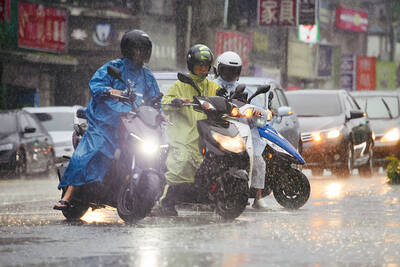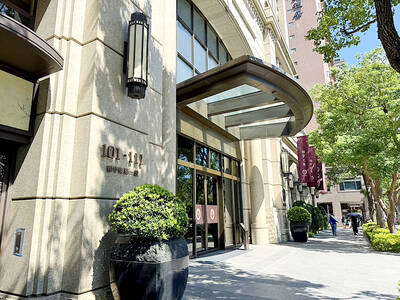The Chung-Hua Institution for Economic Research (CIER, 中華經濟研究院) yesterday cut its GDP growth forecast for the nation this year from the 4.07 percent it forecast in December last year to 3.55 percent, citing the negative impact of the rise in electricity and fuel prices.
The Taipei-based think tank’s forecast was lower than the 3.85 percent full-year economic growth rate predicted by the Directorate-General of Budget, Accounting and Statistics in February.
CIER president Wu Chung-shu (吳中書) attributed the downward revision mainly to the weaker domestic demand.
“The government’s move to raise electricity and gas prices may drag down momentum on private consumption and drive up companies’ operating costs,” Wu told a press conference.
Wu said the rise in electricity and fuel prices is expected to lower growth this year by 0.48 percentage points, an indication the latest downward revision was mainly due to this factor.
CIER also cut its growth forecast for private consumption this year by 0.4 percentage points to 2.24 percent, while expansion of the domestic investment sector is expected to stand at minus-3.32 percent, from the 0.09 percent estimated previously.
The rise in electricity and fuel prices also made the institute raise its growth forecast for inflation to 1.93 percent, up 0.45 percentage points from the December forecast, Wu said, adding that 0.44 percentage points of the upward revision was because of the price rises.
However, since the rising level of headline inflation is due to the government’s one-time adjustment, it does not indicate the nation is facing substantial inflationary pressure, Wu said.
Chu Yun-peng (朱雲鵬), an economics professor at National Central University who attended the press conference, backed Wu’s views.
“The one-time effect from the government’s increase of electricity and fuel prices will not be directly linked to inflation,” Chu said.
Of more vital interest is the trend in international crude oil prices and the US’ potential adoption of a third-round of quantitative easing measures, which may further raise global commodity prices, Chu said.
Tony Phoo (符銘財), an economist at Standard Chartered Bank in Taipei, agreed that compared with the first-round increase of energy prices, a second-round effect of shock price hikes in other daily essentials may lead to higher overall consumer prices.
However, given the current situation, Phoo said the central bank might not raise its policy interest rates this year because of the rising energy prices.
“Our house view is the central bank may raise its policy interest rates by 0.125 percentage points in the first quarter next year, if the momentum of economic expansion recovers as expected,” Phoo said.

The combined effect of the monsoon, the outer rim of Typhoon Fengshen and a low-pressure system is expected to bring significant rainfall this week to various parts of the nation, the Central Weather Administration (CWA) said. The heaviest rain is expected to occur today and tomorrow, with torrential rain expected in Keelung’s north coast, Yilan and the mountainous regions of Taipei and New Taipei City, the CWA said. Rivers could rise rapidly, and residents should stay away from riverbanks and avoid going to the mountains or engaging in water activities, it said. Scattered showers are expected today in central and

COOPERATION: Taiwan is aligning closely with US strategic objectives on various matters, including China’s rare earths restrictions, the Ministry of Foreign Affairs said Taiwan could deal with China’s tightened export controls on rare earth metals by turning to “urban mining,” a researcher said yesterday. Rare earth metals, which are used in semiconductors and other electronic components, could be recovered from industrial or electronic waste to reduce reliance on imports, National Cheng Kung University Department of Resources Engineering professor Lee Cheng-han (李政翰) said. Despite their name, rare earth elements are not actually rare — their abundance in the Earth’s crust is relatively high, but they are dispersed, making extraction and refining energy-intensive and environmentally damaging, he said, adding that many countries have opted to

FORCED LABOR: A US court listed three Taiwanese and nine firms based in Taiwan in its indictment, with eight of the companies registered at the same address Nine companies registered in Taiwan, as well as three Taiwanese, on Tuesday were named by the US Department of the Treasury’s Office of Foreign Assets Control (OFAC) as Specially Designated Nationals (SDNs) as a result of a US federal court indictment. The indictment unsealed at the federal court in Brooklyn, New York, said that Chen Zhi (陳志), a dual Cambodian-British national, is being indicted for fraud conspiracy, money laundering and overseeing Prince Holding Group’s forced-labor scam camps in Cambodia. At its peak, the company allegedly made US$30 million per day, court documents showed. The US government has seized Chen’s noncustodial wallet, which contains

SUPPLY CHAIN: Taiwan’s advantages in the drone industry include rapid production capacity that is independent of Chinese-made parts, the economic ministry said The Executive Yuan yesterday approved plans to invest NT$44.2 billion (US$1.44 billion) into domestic production of uncrewed aerial vehicles over the next six years, bringing Taiwan’s output value to more than NT$40 billion by 2030 and making the nation Asia’s democratic hub for the drone supply chain. The proposed budget has NT$33.8 billion in new allocations and NT$10.43 billion in existing funds, the Ministry of Economic Affairs said. Under the new development program, the public sector would purchase nearly 100,000 drones, of which 50,898 would be for civil and government use, while 48,750 would be for national defense, it said. The Ministry of